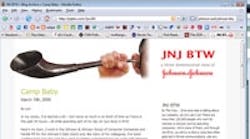In late 2006, the Pew Internet & American Life Project put the number of American adult bloggers at 12 million, or about 8% of adult Americans, a figure which is assuredly larger now. Both the sheer number of people involved in blogging and the influence they wield are combining to make the blogosphere, and the real-world blogger community behind it, a hotly competitive marketing demographic.
Numerous studies have shown that peer recommendation of the type embodied in many blogs consistently receive much higher credibility ratings when compared to normal advertising channels.
Consumer products heavyweight Kimberly-Clark has been employing some cutting-edge online tools to connect in a credible manner with its customers both in the virtual and real worlds, according to AMR senior research fellow Jonathan Yarmis. For instance, the company has created a branded widget that soon-to-be mothers can use to count down due dates, and that can be easily embedded on a local desktop or on the Web in the Facebook or MySpace pages of its consumers. Additionally, it is utilizing online tools like Meetup.com to facilitate face-to-face contact between loyal consumers.
"Kimberly-Clark is sponsoring some of Meetup's parenting groups, picking up the fees the members usually pay to [participate]," reports Yarmis. "While the brands themselves in a way are marketing to the Meetup organizers, they're hoping to connect through them to the members and -- the big win -- through the members to their friends outside the Meetup sphere."
Like Kimberly-Clark, J&J has even established a real-world convocation for influential female "mommybloggers" called Camp Baby -- an event that caused some unfortunate controversy recently when a number of the attendees (those with well-trafficked blogs) were disinvited to a purposely "intimate" event.
The resulting "blogstorm" created some unwelcome publicity for both the brand and its outreach event, and served to overshadow the unique and Web-savvy way that J&J was going about promoting it -- a strategy that included using a variety of Web 2.0 tools, including Technorati, Google, blogrolls, Quancast, blog roundup posts as well as leveraging Johnson's pre-existing blogger relationships, according to lead organizer Lori Dolginoff.
See Also



